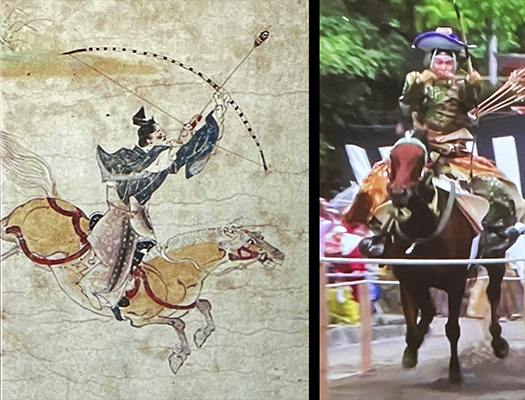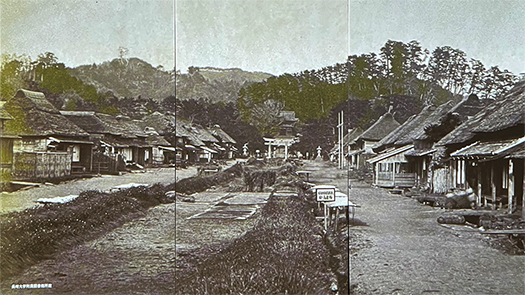

本日から3泊4日で外泊の予定。ということでその前に事務多忙。出掛けてしまえば逆に時間も確保できると思うのでたくさんの過去写真を整理してブログのテーマを絞りたい。
鎌倉をテーマとして写真を整理していたときに加工した写真が上のもの。流鏑馬神事は鎌倉鶴岡八幡宮が有名ですが、仙台でもわたしは参観したことがあります。歴史的には鶴岡八幡宮の創始に際して頼朝政権が奉納したのが、はじまりというように言われる。その下の写真は明治初期に日本を訪れた欧米の写真家が全国を行脚して撮影したもののひとつで、鶴岡八幡宮から若宮大路の様子が表現されている。
こういう絵画や写真群は、文献資料を超えてさまざまな「情報」を伝えてくれます。絵画に描かれた流鏑馬の画角はやや上空からの角度を取って表現している。現実にはこのようなやや上空視点からの視認映像はありえなかっただろうと思われる。日本の歴史事実を伝える絵画、屏風絵などではほぼ一様にこうした視覚からの表現がとられている。日本の歴史報道画の一種の定型パターンなのだと思われます。王朝絵画などで十二単を着飾った宮廷美人たちもほぼこういった視覚角度で描かれるし、動乱のニュース画面でも一様にこのパターン。たぶん日本史や東アジア世界での共通的な視点なのだろうか。
現代に至る写真表現では、基本的に撮影者の自然な「立ち位置」からの視点が普遍的に取られる。明治初年の海外人の視点としてごく平明に、当時の状況の「記録写真」であって比較対照しやすい。当たり前だけれど、この両者を対比させると、画像に対しての歴史的認識の違いに気付かされる。
たぶん歴史事実を伝える視覚角度は周辺説明アングルとして多くの情報をそこに盛り込むことができるということが眼目のように思われる。洛中洛外図という表現形式はかなり長く日本史で描かれ続けたけれど、あれなどは京の街の多種多様な賑わいぶりを遠方の人びとにもわかりやすく、また絢爛豪華に伝えられたのでしょう。織田信長が越後の上杉謙信の歓心を買うのに、洛中洛外図を送った故事の意味がわかる。報道伝達性の「関係性一挙表現」と考えるとその知恵の深さを知らされる思い。
逆に言うと,現代的表現では「切り取り方」でたぶん受け取る印象は相当に変位する。
さてどっちの手法がより「客観的」であるかは、受け取り方によって違うでしょうね。案外、昔人の巨視的関係性一挙把握のほうが、リアリズムに近しいかも知れない。
English version⬇
Historical paintings and contemporary photographs: Differences in viewing angles
Historical news visuals convey peripheral facts and human relations from a slightly elevated perspective in an easy-to-understand manner. Contemporary photography risks being “clipped” due to its directness. Which is more objective? Which is superior in terms of objectivity?
We are planning to stay out of town for 3 nights and 4 days starting today. So I have a lot of office work to do before that. I think I will have more time once I go out, so I want to organize a lot of past photos and narrow down the theme of my blog.
The photos above are the ones I processed when I was organizing photos on the theme of Kamakura. The famous yabusame (horseback archery) ritual is held at Tsurugaoka Hachiman-gu Shrine in Kamakura, but I have also attended one in Sendai. Historically, it is said that it started when the Yoritomo administration dedicated the shrine at the time of the founding of Tsurugaoka Hachiman-gu Shrine. The photograph below is one of many taken by Western photographers who visited Japan in the early Meiji period (1868-1912), and depicts the scene from Tsurugaoka Hachiman Shrine to Wakamiya-oji Avenue.
Paintings and photo groups like these convey a variety of “information” beyond the literary sources. The angle of the yabusame archery depicted in the paintings is expressed from a slightly elevated angle. In reality, such a visual image from a slightly elevated viewpoint would not have been possible. Paintings and screens depicting historical facts in Japan almost uniformly use this type of visual representation. It is thought that this is a kind of standard pattern of Japanese historical reporting paintings. Court beauties dressed in juni-hitoe (twelve-layered kimono) are almost always depicted from this visual angle, and this pattern is also uniform on news screens during upheavals. Perhaps this is a common viewpoint in Japanese history and East Asia.
In photographic expression up to the present day, the viewpoint from the photographer’s natural “standing position” is universally taken. The photographs are very plain as the viewpoint of a foreigner in the early Meiji era, and they are “record photos” of the situation at that time, which can be easily compared and contrasted. It is natural, but when we contrast the two, we realize the difference in historical perceptions of the images.
Perhaps the visual angle that conveys the historical facts is the one that can contain a lot of information as a peripheral explanatory angle. The “Rakuchu-Rakugaizu” style has been used for quite a long time in Japanese history, and it is likely that it conveyed to people far from Kyoto the variety and splendor of the bustling city in an easy-to-understand manner. We can understand the significance of the legend that Oda Nobunaga sent the Rakuchu-Rakugaizu to Uesugi Kenshin in the Echigo region to win his favor. When I think of it as a “one-stop expression of the relationship” of news transmission, I am informed of the depth of the wisdom of this expression.
Conversely, in modern expression, the impression received may vary considerably depending on the “way of cutting.
Now, which method is more “objective” will depend on how you receive it. Surprisingly, the old people’s macroscopic grasp of relationships may be closer to realism.
Posted on 4月 12th, 2023 by 三木 奎吾
Filed under: 歴史探訪







コメントを投稿
「※誹謗中傷や、悪意のある書き込み、営利目的などのコメントを防ぐために、投稿された全てのコメントは一時的に保留されますのでご了承ください。」
You must be logged in to post a comment.